| Sango was the 4th king that ruled as the Alafin of Oyo and who was deified by his friends after his controversial death. According to Yoruba legend, Sango was born at a time when the Yoruba people were participating in activities that were unpleasing to the gods. He entered the world with a twin and this inspired his patronage for the cult of twins. When he attained the position of king, Sango would punish his enemies by utilizing his ability to control thunder and he gained the title God of Thunder. Different stories have been found about the manner in which he died. Some sources say he exerted too much power and was the victim of regicide (nubacom.com21century Yoruba). Sango’s death has also been linked to suicide. Whatever the case, Sango was elevated to the status of orisha and his followers have produced some extraordinary work celebrating the God of Thunder. | |
| The best translation for "Afin" is "palace." These were the homes of the Oba or rulers and the center of the Yoruba community. "All roads led to the Afin. For it contained, among other things, the town’s assembly hall, Court of justice, theatre and sports ground" (Ojo p.? ) | A photograph (below) taken by John Pemberton in 1971 (Drewal, Pemberton & Abiodun, p.161) indicates the colorful nature of Yoruba architectural painting that Frobenius notes in his own comments. |
| The fifteen veranda posts (click on the shrine image to get a larger picture and a better view of the fifteen posts) that stand outside the shrine are seen to be the work of various carvers. This was a common occurrence among the Yoruba as the most talented individuals from local and distant towns would be used. Frobenius described the posts as "sculptured with horsemen, men climbing trees, monkeys, women, great kings, and all sorts of mythological carved work" (nubacom.com/21stCentury Yoruba). The posts stand nine on the right of the entrance and six to the left. The posts are not all associated with Sango. For example, a follower of Orisha Oko is present. Furthest to the right is a carving of a Muslim figure, dressed entirely in white. The Yoruba accepted Allah as just another orisha to be a part of the shrine. According to Pemberton, the monkey is closely related to the cult of the ancestors. Fire ravaged many of the veranda posts, but somewhat successful attempts to restore them were made (Drewal, Pemberton & Abiodun, p.166). |  |